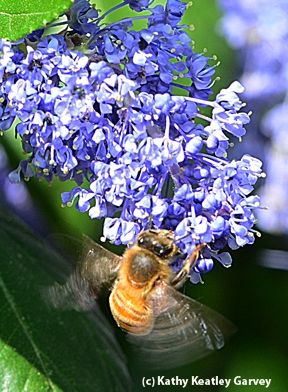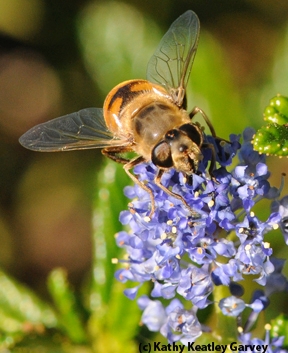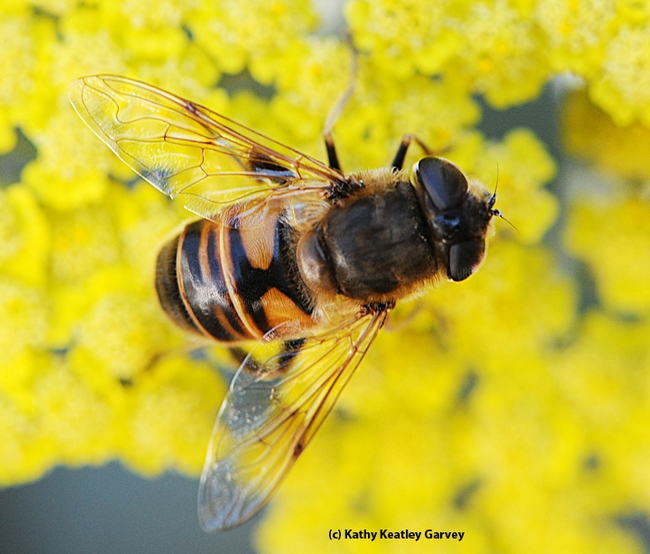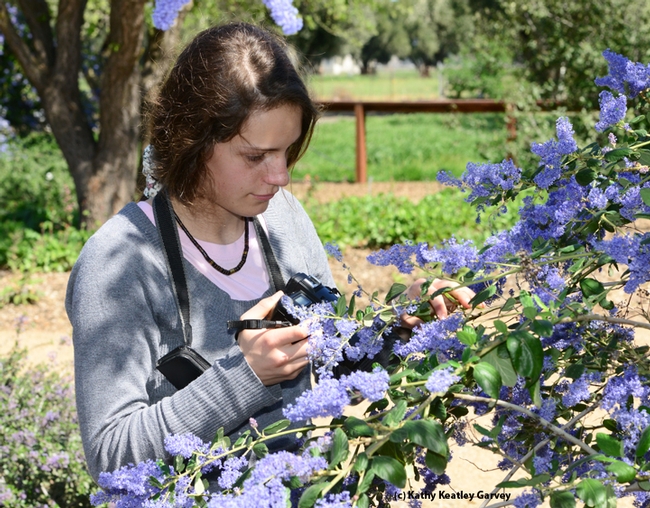
Indeed, to the untrained eye, the drone fly (Eristalis tenax) appears to be a bee. It's not; it's a fly.
Native pollinator specialist Robbin Thorp, emeritus professor of entomology at UC Davis, calls the drone fly "The H Bee." That's because there's an "H" on its abdomen (see photo). Like all flies, however, it can be distinguished by one pair of wings and stubby antennae. The larva of the fly is a rat-tailed maggot that lives in drainage ditches, pooled manure piles and other polluted water. The adults are floral visitors. Pollinators.
The "H Bee" was among the pollinators that Thorp discussed at the UC Davis Pollinator Gardening Workshop, hosted March 6 by the California Center for Urban Horticulture.
Extension apiculturist Eric Mussen of the UC Davis Department of Entomology and Nematology, switched from bee mimics (drone flies, syrphid flies and other insects) to talk about the "real" honey bees, Apis mellifera, which European colonists introduced to what is now the United States in 1622. "The honey bees' biggest problem today is malnourishment," he said. "A single honey bee colony requires an acre of bloom to meet its nutritional needs each day," he said.
The queen can lay 2000 eggs a day in peak season. "One cell of honey and one cell of pollen make one bee."
He urged the participants to "try to plant for late summer and fall bloom, when honey bees in California are having a hard time finding nectar and pollen resources."

Mussen cautioned that bees are subjected to toxic pollens and unnatural toxins (pesticides). Plants poisonous to bees include the California buckeye (Aesculus californica) death camas (Toxicoscordion venenosum), corn lily (Veratrum californicum) and some locoweeeds (Astragalus spp.)
Pesticides inside the hive (used to control varroa mites) and outside the hives can be fatal. However, he said, "any kind of pesticide a bee encounters--there's always a physiological change."
Following the morning-long speaker presentations, the participants visited the UC Davis Arboretum Teaching Nursery on Garrod Drive to check out and/or purchase Arboretum All-Stars and other plants, and they toured the Häagen-Dazs Honey Bee Haven, a half-acre bee friendly garden on Bee Biology Road that is under the wing of the UC Davis Department of Entomology and Nematology. The garden is located next to the Harry H. Laidlaw Jr. Honey Bee Research Facility.
Among those traveling the longest distance were Lake Tahoe UC Master Gardeners Lynne Broche and Bonnie Turnbull and Turnbull's 14-year-old daughter, Jessie Brown, a junior Master Gardener and an avid insect photographer.
The ceanothus blooming in the haven especially drew the attention of the workshop participants. Insects foraging in the ceanothus included two so-called "H bees"--the honey bee and its impostor, the H-marked drone fly.
Attached Images:

The drone fly, Eristalis tenax, is often mistaken for a bee. The fly has the letter "H" on its thorax. (Photo by Kathy Keatley Garvey)

essie Brown, 14, a junior UC Master Gardener with the Lake Tahoe Master Gardeners, photographs insects in the ceanothus at the Häagen-Dazs Honey Bee Haven. (Photo by Kathy Keatley Garvey)